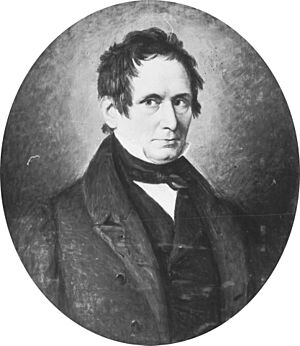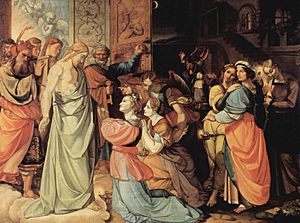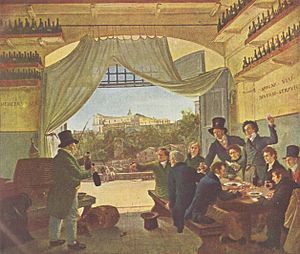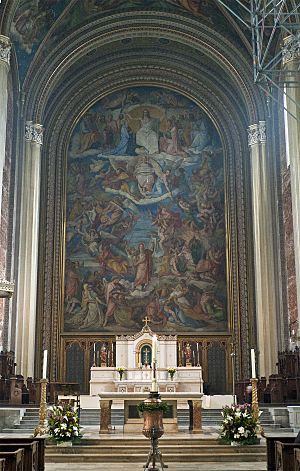Peter von Cornelius facts for kids
Peter von Cornelius (born September 23, 1783, died March 6, 1867) was an important German painter. He was a key artist in a group called the Nazarene movement. This group wanted to bring back the style of early Italian Renaissance art. Cornelius is known for his large fresco paintings, which are murals painted on wet plaster.
Contents
Life of Peter von Cornelius
Early Years and Art Training
Peter von Cornelius was born in Düsseldorf, Germany. His father was in charge of the Düsseldorf art gallery. He was also a professor at the art academy there. From the age of twelve, Peter started taking drawing classes at this academy.
When his father died in 1799, Peter was only 16. He had to support his family. He did this by painting portraits and creating illustrations for books. One of his first big projects was decorating a church choir in Neuss in 1803.
In 1809, he started drawing pictures for a famous book. This book was Faust by the writer Goethe. Cornelius used a simple, clear line style for these drawings. He was inspired by the artist Albrecht Dürer. Goethe himself liked six of these drawings. Cornelius finished the series later in Rome. The drawings were published as engravings between 1816 and 1826. In 1809, he moved to Frankfurt. Two years later, he went to Rome.
Time in Rome with the Nazarenes
Cornelius arrived in Rome on October 14, 1811. He quickly joined a group of young German artists. They called themselves the Lukasbund, or "Nazarene Brotherhood." This group included artists like Johann Friedrich Overbeck and Friedrich Wilhelm Schadow. They lived together in an old convent. They studied art seriously and helped each other improve.
In Rome, Cornelius worked with other Nazarene artists. They decorated the Casa Zuccari, a building where the Prussian consul lived. They also worked on the Villa Massimi. At the same time, Cornelius also made designs for illustrations of the Nibelungenlied. This is a famous German epic poem.
Returning to Germany and New Roles
In 1819, Cornelius left his work in Rome unfinished. He was called back to Germany by the crown-prince of Bavaria. This prince later became King Ludwig I. The king wanted Cornelius to lead the decorations for his new sculpture gallery. This gallery was called the Glyptothek in Munich.
In 1821, Cornelius also became the director of the Düsseldorf Academy. However, he found it too hard to manage both jobs. So, he eventually left his position in Düsseldorf. Some of his students even followed him to Munich to help him there. In 1824, he became the director of the Munich Academy.
Major Works in Munich and Berlin
The fresco paintings in the Ludwigskirche in Munich were very important. Cornelius designed and painted most of them. The huge fresco of The Last Judgment is above the main altar. It is about 62 feet (19 meters) tall and 38 feet (12 meters) wide. Other large frescoes in the church show the Creator, the Nativity, and the Crucifixion.
Other important works in Munich included his decorations. These were in the Pinakothek art museum and the Glyptothek sculpture gallery. The paintings in the Glyptothek, showing gods and heroes, are very well known. Around 1839–40, Cornelius moved from Munich to Berlin. He began working on a series of large drawings called cartoons. These showed scenes from the Apocalypse. King Frederick William IV had ordered these for a royal tomb in Berlin. The king stopped his plans after the revolution of 1848. But Cornelius kept working on these drawings for the rest of his life.
He stayed in touch with artists in Rome. He even lived there again between 1853 and 1869.
Art Style and Techniques
Peter von Cornelius was not very skilled at oil painting. His oil works do not show a good sense of color. Even as a fresco painter, his hand skills were not amazing. When you look closely at his large designs, you might feel he couldn't quite bring them to life with color.
Cornelius and his friends tried to paint like the old Italian masters. But they also had a strong influence from the German artist Albrecht Dürer. This Dürer influence sometimes made his compositions look a bit crowded. It also affected the way he drew people's bodies. These details can even be seen in his main work, The Last Judgment.
Despite these small issues, his works always show a grand and noble idea. He might not have been great with a brush, but he was a master at planning and designing. He had a huge vision for German painting. His favorite saying, "Deutschland uber alles" (Germany above all), showed his strong love for his country.
Cornelius often had his students and assistants help him. They would even help design parts of the projects he led. For example, the drawings for the Glyptothek were all his own. But for the Pinakothek, his small sketches were enough. For the Ludwigskirche, some of the ideas were even given to his student Hermann. His students included Karl Friedrich Hermann, Wilhelm von Kaulbach, and Adam Eberle.
Influence on Art
In 1855, a writer named Théophile Gautier said that Cornelius was famous. He said few artists were so admired during their lives. To understand how much Cornelius did for Germany, we need to remember something. At the start of the 1800s, Germany did not have its own national art style. Germany was behind other European countries in painting and sculpture.
But in less than 50 years, Cornelius created a great art school. He brought back mural painting. He made Munich a center of the art world. The German revival of mural painting also influenced England and other countries. It led to famous art competitions in Westminster Hall. This eventually helped decorate the Houses of Parliament in London. In 1841, Cornelius visited England. He thought the fresco project there was a good idea. He even believed frescoes would last well in the English climate.
Cornelius always taught his students to study nature very closely. But he meant more than just drawing from life. He wanted them to study nature with a curious, scientific mind. He once advised, "Study nature, so that you may become familiar with its basic forms."
See also
 In Spanish: Peter von Cornelius para niños
In Spanish: Peter von Cornelius para niños
- List of German painters





